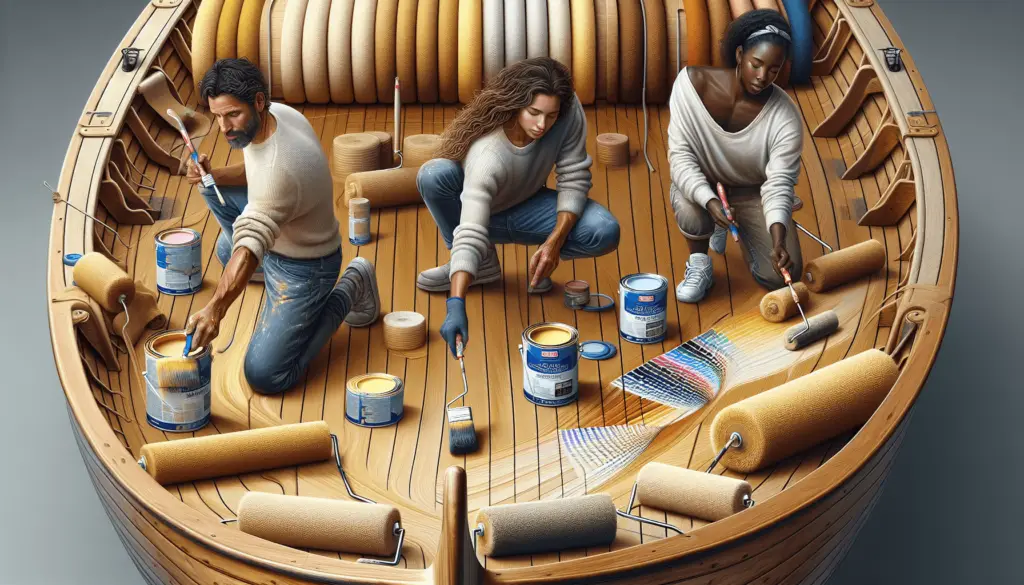Are you a boat owner looking to spruce up your vessel? If so, you’ve come to the right place! In this comprehensive buyer’s guide, we will walk you through everything you need to know about choosing the right paint and finishes for your boat. From the different types of boat paints available to the various finishes and their specific purposes, we’ve got you covered. So, sit back, relax, and let us help you make an informed decision that will not only protect your boat but also enhance its appearance on the water.

Types of Boat Paints and Finishes
When it comes to painting your boat, there are different types of paints and finishes available to suit various needs and applications. Understanding these different types can help you make an informed decision when choosing the right paint and finishes for your boat.
1.1. Bottom Paints
Bottom paints are specifically designed for the hull of your boat, providing protection against the harsh underwater environment. These paints are formulated to prevent the growth of marine organisms such as algae and barnacles, which can damage the hull and affect the boat’s performance.
1.2. Topside Paints
Topside paints are used on the upper areas of the boat, above the waterline. These paints not only provide a decorative finish but also offer protection against the damaging effects of sunlight, saltwater, and other environmental elements. They come in various gloss and finish options, allowing you to customize the look of your boat.
1.3. Deck and Cabin Paints
Deck and cabin paints are designed for the surfaces exposed to heavy foot traffic and harsh weather conditions. These paints offer excellent durability, slip resistance, and resistance to sun, salt, and chemicals. They are specifically formulated to withstand the rigors of marine environments, ensuring that your boat’s deck and cabin remain in top shape for years to come.
1.4. Primers and Undercoats
Primers and undercoats play a crucial role in the process of painting your boat. They provide a smooth and even base for the topcoat, enhance adhesion, and improve the overall durability of the paint system. Primers also help in preventing corrosion and ensure proper bond between the hull and the paint.
Considerations before Choosing Boat Paints and Finishes
Before you dive into the world of boat paints and finishes, there are a few essential considerations to keep in mind. These factors will help you make the right choice for your specific needs and ensure that the paint and finishes you choose provide the desired results.
2.1. Durability and Protection
One of the primary considerations when choosing boat paints and finishes is durability and protection. You want a paint system that can withstand the harsh marine environment, including exposure to sunlight, saltwater, and constant use. Look for paints that offer excellent resistance against these factors to ensure the longevity and protection of your boat.
2.2. Compatibility and Adhesion
Another critical factor to consider is the compatibility and adhesion of the paint system. The paint and finishes should be compatible with the boat’s material, whether it is fiberglass, wood, or metal. Additionally, ensuring proper adhesion is crucial to prevent peeling or chipping of the paint over time.
2.3. Environmental Impact
As responsible boat owners, it is essential to consider the environmental impact of the paints and finishes you choose. Look for paints that are eco-friendly and have low VOC (volatile organic compounds) content. These paints are not only better for the environment but also for your own health and safety during application.
2.4. Ease of Application
Consider the ease of application when choosing boat paints and finishes. Some paints require multiple coats or specific application techniques, while others offer a more straightforward and user-friendly application process. Assess your own skill level and the amount of time you are willing to invest in the painting process to make the right choice.
Factors to Consider for Bottom Paints
When it comes to bottom paints, there are specific factors to consider that are crucial for the performance and protection of your boat’s hull.
3.1. Boat Type and Material
The type and material of your boat play a significant role in determining the type of bottom paint you should choose. Different boats, such as sailboats or powerboats, may require specific types of bottom paints. Additionally, consider whether your boat is made of fiberglass, wood, or metal, as each material may require a different type of paint for optimal performance.
3.2. Water Conditions and Speed
Water conditions and the speed at which you typically operate your boat also influence the choice of bottom paint. If you frequently navigate in saltwater or brackish water, you may need a paint that offers superior anti-fouling properties to prevent the growth of marine organisms. Additionally, boats that travel at higher speeds may benefit from bottom paints that reduce friction and enhance performance.
3.3. Antifouling Properties
Antifouling properties are crucial for bottom paints, as they help prevent the growth of marine organisms on the hull. Look for paints that utilize effective antifouling agents, such as copper or biocides, to ensure that your boat remains free from barnacles, algae, and other unwanted growth. Consider the specific fouling issues in your boating area to choose the most appropriate antifouling bottom paint.
Factors to Consider for Topside Paints
When it comes to topside paints, there are different factors to consider to achieve the desired aesthetic appeal and protection for the upper areas of your boat.
4.1. Gloss and Finish Options
Topside paints come in a range of gloss and finish options, allowing you to choose the appearance that suits your personal preferences and boat style. High gloss finishes can provide a sleek and shiny look, while satin or matte finishes offer a more subdued and classic appearance. Consider the level of gloss and finish that aligns with your boat’s overall aesthetics.
4.2. UV Resistance
Sunlight can be detrimental to the appearance and longevity of topside paints. Look for paints that offer excellent UV resistance, as they will better withstand the damaging effects of sunlight and retain their color and finish over time. UV-resistant topside paints ensure that your boat’s upper areas remain vibrant and protected from fading or dulling.
4.3. Color Retention
Color retention is another vital factor to consider for topside paints. Some paints are formulated to maintain their color vibrancy even after continuous exposure to sunlight and environmental elements. Choose paints that offer superior color retention to ensure that your boat remains aesthetically pleasing and does not require frequent repainting.

Factors to Consider for Deck and Cabin Paints
Deck and cabin paints require specific considerations to ensure optimal performance and longevity in these high-traffic areas.
5.1. Slip Resistance
Safety should be a top priority, especially for deck areas that are frequently exposed to water and foot traffic. Deck and cabin paints with slip-resistant properties provide additional traction, helping to prevent accidents caused by slippery surfaces. Look for paints that have textured finishes or incorporate anti-slip additives for enhanced safety on your boat’s deck and cabin.
5.2. Resistance to Sun, Salt, and Chemicals
Deck and cabin paints should offer excellent resistance to sunlight, saltwater, and chemicals. These areas are often exposed to harsh environmental conditions, including UV rays, seawater, and cleaning products. Choosing paints that are specifically formulated to withstand these factors ensures that your boat’s deck and cabin maintain their appearance and functionality for an extended period.
5.3. Ease of Cleaning
Decks and cabins require regular cleaning to remove dirt, stains, and salt residue. Consider deck and cabin paints that offer ease of cleaning to simplify the maintenance process. Some paints have smooth and non-porous finishes that allow for effortless cleaning, making it easier to keep your boat looking its best without extensive scrubbing or the use of harsh chemicals.
Factors to Consider for Primers and Undercoats
Primers and undercoats provide the foundation for a durable and long-lasting paint system. Consider the following factors when choosing primers and undercoats for your boat.
6.1. Surface Preparation
Surface preparation is crucial before applying any paint or undercoat. Different surfaces require different preparation methods, such as sanding, cleaning, or priming. Consider the condition of your boat’s surface and choose primers and undercoats that are compatible with the material and can provide a smooth and even base for the topcoat.
6.2. Adhesion and Bonding
Proper adhesion between the primer, undercoat, and topcoat is essential for the longevity and durability of the paint system. Look for primers and undercoats that provide excellent adhesion and bonding properties to ensure that the layers of paint adhere together securely. This helps prevent issues such as peeling, cracking, or chipping of the paint over time.
6.3. Compatibility with Topcoats
Ensure that the primers and undercoats you choose are compatible with the topcoats you plan to use. Different types of primers and undercoats may be specifically formulated for certain topcoat brands or types. Checking for compatibility ensures a seamless and effective transition between layers, resulting in a more professional and long-lasting paint job.

Application Techniques for Boat Paints and Finishes
Once you have chosen the right paints and finishes for your boat, it is important to consider the appropriate application techniques. Different paints may require specific methods to achieve optimal results.
7.1. Surface Preparation
Before applying any paint or finish, thorough surface preparation is crucial. This involves cleaning the surface, removing any loose paint or debris, and ensuring a smooth and even base. Follow the manufacturer’s instructions for surface preparation, as each type of paint may have specific requirements.
7.2. Brushing
Brushing is a common and traditional method of applying paint. It allows for better control and precision, especially in hard-to-reach areas or areas with intricate details. When brushing, use high-quality brushes suitable for the type of paint you are using, and apply thin and even coats for optimal coverage and finish.
7.3. Rolling
Rolling is another popular technique for applying boat paints and finishes. It is often used for larger areas, such as the hull or deck. Use appropriate paint rollers suitable for marine applications, and ensure that the paint is applied evenly and without dripping or pooling. Roll in one direction to achieve a smooth and consistent finish.
7.4. Spraying
Spraying is a faster and more efficient method for applying paint to large areas or areas with complex shapes. It requires specialized equipment, such as spray guns or paint sprayers. When spraying, ensure proper ventilation and follow safety precautions to prevent overspray or inhalation of paint fumes. Practice on test surfaces before applying the paint to your boat to ensure a professional and even finish.
Maintenance and Longevity
Proper maintenance is essential to extend the longevity and preserve the appearance of your boat’s paint and finishes. Regular cleaning, touch-ups, and occasional re-coating can help keep your boat looking its best for years to come.
8.1. Regular Cleaning
Regularly clean your boat’s painted surfaces to remove dirt, salt residue, and other contaminants. Use gentle cleaners that are specifically formulated for marine applications to avoid damaging the paint. Regular cleaning prevents the buildup of grime or stains, keeping your boat looking fresh and well-maintained.
8.2. Touch-ups and Repairs
Inspect your boat’s paint regularly for any signs of damage, such as chipping or peeling. Address any minor issues promptly with touch-up paint to prevent further damage and maintain the overall integrity of the paint system. Larger repairs may require professional assistance to ensure a seamless and professional finish.
8.3. Refreshing or Recoating
Over time, the paint and finishes on your boat may show signs of wear or fading. Consider refreshing or recoating the surfaces to restore their appearance and protection. Depending on the type of paint used, this may involve sanding or priming before applying a fresh coat of paint. Follow the manufacturer’s instructions and consider professional assistance for more extensive refresh or recoating projects.

Recommended Brands and Products
Choosing the right brands and products for your boat’s paint and finishes can make a significant difference in the overall quality and longevity of your paint job. Here are some recommended brands to consider:
9.1. Bottom Paints: Brand X
Brand X offers a wide range of bottom paints that are known for their excellent antifouling properties and durability. Their paints provide reliable protection against marine growth and are suitable for different boat types and materials. Consider Brand X for bottom paints that deliver long-lasting performance and peace of mind.
9.2. Topside Paints: Brand Y
Brand Y is a trusted name in topside paints, offering a variety of gloss and finish options to suit different preferences. Their paints are known for their UV resistance, color retention, and ease of application. Look to Brand Y for topside paints that provide both aesthetic appeal and exceptional protection.
9.3. Deck and Cabin Paints: Brand Z
Brand Z specializes in deck and cabin paints that are designed to withstand heavy foot traffic and harsh environmental conditions. Their paints offer superior slip resistance, resistance to sun, salt, and chemicals, and ease of cleaning. Choose Brand Z for deck and cabin paints that prioritize safety, durability, and low maintenance.
9.4. Primers and Undercoats: Brand A
Brand A provides reliable primers and undercoats that ensure proper adhesion, surface preparation, and compatibility with topcoats. Their products are trusted by professionals and DIY enthusiasts alike for their ease of use and ability to enhance the performance of the entire paint system. Consider Brand A for primers and undercoats that lay the foundation for a successful paint job.
Budget Considerations and Cost
Considering your budget and the cost of paints and finishes is an important aspect of the decision-making process. While it may be tempting to opt for the cheapest options available, it is essential to balance cost with quality and longevity.
10.1. Cost of Paint and Finishes
The cost of paints and finishes can vary depending on the brand, type, and quality. Higher-quality paints and finishes may come at a premium price, but their durability and performance often justify the investment. Consider your budget and research different brands and products to find the best value for your money.
10.2. Additional Equipment or Services
Keep in mind that the cost of paints and finishes may not be the only expense involved. Depending on the complexity of the project, you may need additional equipment or services, such as brushes, rollers, or professional assistance for extensive paint jobs. Factor in these additional costs when planning your budget to ensure a successful and cost-effective paint job.
In conclusion, choosing the right paints and finishes for your boat is a critical decision that requires careful consideration of various factors. By understanding the different types of boat paints, considering important factors, and following proper application techniques, you can achieve a durable and visually appealing paint job. Regular maintenance and attention to touch-ups and repairs will help extend the longevity of your boat’s paint and finishes. Remember to choose reputable brands and products that align with your specific needs and budget, ensuring the best results for your boat.


